The Wheat Penny, also known as the Wheat Cent, gets its nickname from the two stylized ears of wheat featured on the reverse of the coin. In 1948, while the U.S. military experienced major milestones—like the end of racial segregation, the formation of the Women in the Air Force (WAF), and the renaming of Women Marines—collectors continued their focus on numismatics.
Let’s take a closer look at the 1948 Wheat Penny value and the factors that influence it.
1948 Wheat Penny Value Chart
| Coin Type | MS60 | MS62 | MS64 | MS65+ | MS66+ | MS67+ |
|---|---|---|---|---|---|---|
| 1948 (No Mint Mark) | $2 | $4 | $18 | $38 | $400 | $5,000 |
| 1948-D (Denver Mint) | $3 | $5 | $12 | $28 | $125 | $1,700 |
| 1948-S (San Francisco Mint) | $2 | $4 | $12 | $22 | $45 | $1,050 |
*All prices are based on coins with a red color designation.
History of the 1948 Wheat Penny
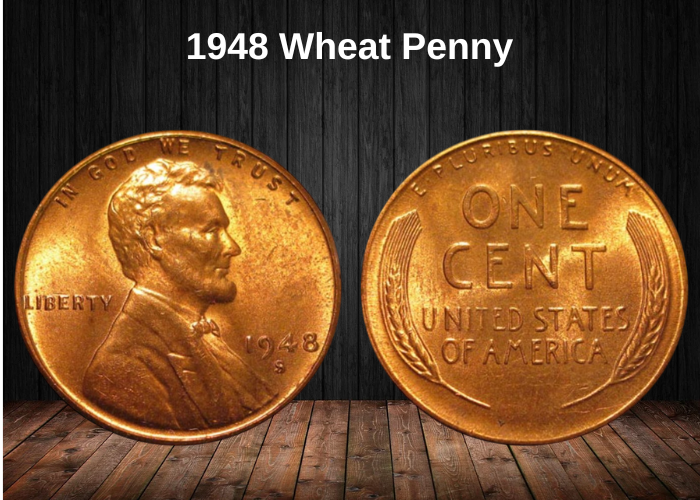
The obverse—or “heads” side—of the penny has featured the same design since 1909. However, the reverse (or “tails” side) has undergone several redesigns over the decades. The earliest of these was the Wheat Cent, also known as the Wheat Penny, created by Victor David Brenner.
Born Avigdor ben Gershon, Brenner was a Lithuanian-Jewish immigrant who came to the United States at the age of 19. He had learned the art of engraving and gem carving from his father, and this skill gave him a foundation in sculpting. Eager to expand his abilities, he taught himself English and French, and went on to study at art institutions in both New York and Paris.
His talent eventually brought him to the attention of Augustus Saint-Gaudens, a renowned sculptor, who took him on as a studio assistant. This connection led Brenner to the U.S. Mint, where he was commissioned to design the one-cent coin in 1909.
The project had roots in a broader initiative led by President Theodore Roosevelt, who wanted to beautify American coinage. Roosevelt had enlisted his friend Saint-Gaudens to oversee the redesign. However, after Saint-Gaudens passed away from cancer, several of his protégés—including Brenner—continued the work. That’s how the first coin to feature a U.S. president, the Lincoln cent, came to be.
Designing the Wheat Penny
Victor David Brenner was commissioned to sculpt a new portrait of Abraham Lincoln, the 16th president of the United States. For his design, he drew inspiration from a Lincoln plaque he had previously created in 1907 for Gorham Manufacturing. When it came to designing the reverse, Brenner turned to the French coinage he admired—understandably so, given his Parisian education and his mentorship under a French-trained sculptor.
His early concept sketches included a tree branch, similar to what was seen on contemporary French silver coins. Other drafts were influenced by the Standing Liberty imagery popular in France at the time. But Frank A. Leach, the U.S. Mint Director, suggested a revision, asking Brenner to replace the tree. In response, Brenner opted for a simpler, more symbolic design: two stylized stalks of wheat. This became the reverse that gave the coin its famous nickname—the Wheat Cent.
That wheat motif, made from the durum variety, remained in use until 1959, when it was replaced by the Lincoln Memorial to mark the 150th anniversary of Lincoln’s birth.
While 1948 Wheat Cents do feature the “VDB” initials (for Victor David Brenner), earlier coins did not. This omission was due to a disagreement between Brenner and then-Chief Engraver Charles Barber. The original initials were considered too prominent, and rather than adjust their size, the Mint removed them altogether. They were reinstated—subtly—on the obverse in 1918.
Features of the 1948 Wheat Penny
The Obverse of the 1948 Wheat Penny
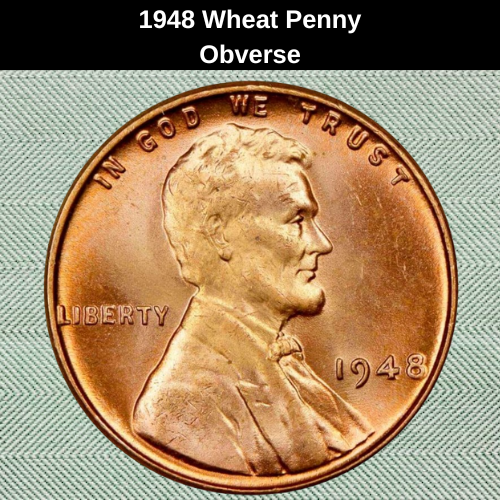
The obverse of the coin features a profile portrait of Abraham Lincoln, the 16th President of the United States. Above his head is the national motto, “IN GOD WE TRUST”, while the word “LIBERTY” appears just behind his shoulder. The date and, if applicable, the mint mark are positioned in front of Lincoln’s chest. Just at the base of his shoulder, you’ll find the initials “VDB”, honoring the coin’s designer, Victor David Brenner.
The Reverse of the 1948 Wheat Penny
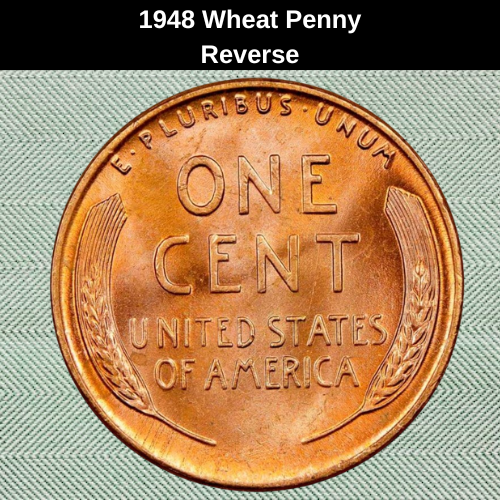
The reverse of the coin features two stalks of durum wheat, one on each side, framing the central inscriptions. At the top, between the tips of the wheat stalks, is the Latin motto “E PLURIBUS • UNUM”, with a dot on either side of “Pluribus.” Just below that, in bold letters, is the denomination — “ONE CENT” — followed by “UNITED STATES OF AMERICA” at the bottom.
Additional Details of the 1948 Wheat Penny
The 1948 Wheat Penny is composed of 95% copper, with the remaining 5% made up of zinc, tin, or a combination of both. It has a diameter of 19.05mm (equivalent to 0.75 inches) and weighs 3.11 grams. The coin features a plain edge, meaning it has no reeding or ridges. Its copper surface can appear in one of three color designations: red, red-brown, or brown, depending on age and exposure.
1948 Wheat Penny Grading
As mentioned earlier, the color grade plays a major role in a coin’s value:
- Red (RD) – Highest quality, retains at least 95% of its original mint luster.
- Red-Brown (RB) – Partial luster, with 5% to 95% red surfaces.
- Brown (BN or BRN) – Least valuable, showing heavy oxidation and dark tones.
In addition to color, coins are graded using the Sheldon Scale, a 1–70 point system that measures wear and condition. Coins also carry adjectival grades, describing their condition in plain terms.
| Sheldon Grade | Adjectival Grade |
|---|---|
| 1 | Basal State-1 |
| 2 | Fair |
| 3 | Very Fair |
| 4–6 | Good |
| 7–10 | Very Good |
| 12–15 | Fine |
| 20–30 | Very Fine |
| 40 | Extremely Fine |
| 50 | About Uncirculated |
| 60 | Mint State |
| 65 | Gem Mint State |
| 70 | Perfect Mint State |
Keep in mind: Wheat Cents tend to wear down quickest on the denomination (“One Cent” on the reverse), so pay close attention to that area when grading.
🔍 Tip: Refer to a detailed coin grading guide or use a loupe for accurate evaluation—it’s a key step in determining your penny’s true worth.
1948 Wheat Penny Value Guides
Several key elements influence the value of 1948 Wheat Pennies, including:
🔹 Minting Location
In 1948, pennies were produced at three U.S. Mint facilities:
- Philadelphia (No mint mark)
- Denver (D mint mark)
- San Francisco (S mint mark)
Each mint struck regular circulation coins, also known as business strikes. It’s important to note that no proof coins were minted from 1943 to 1949, so every 1948 penny you encounter was made for everyday use.
🔹 Rarity
While 1948 pennies are generally common, their survival in high grades—especially with red color and gem mint condition—is much rarer, increasing their value.
🔹 Mint Errors
Unique error coins like double die obverses, re-punched mint marks (RPMs), and off-center strikes can raise a coin’s market price significantly.
🧠 Understanding where and how a coin was minted is the first step to unlocking its potential value.
1948 No Mint Mark Wheat Penny Value
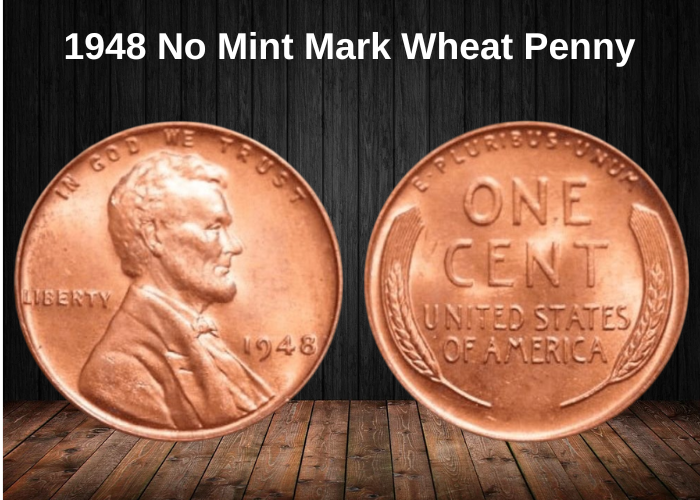
The 1937 Wheat Penny is a copper one-cent coin from the Lincoln Wheat Cent series, minted in the United States between 1909 and 1958. Designed by Victor David Brenner, the coin features the profile of President Abraham Lincoln on the obverse, while the reverse shows two wheat ears surrounding the inscription “ONE CENT,” symbolizing agricultural prosperity.
The year 1937 was part of the pre-World War II era, a time when the United States was slowly recovering from the Great Depression and beginning to experience industrial growth. Although no major political or economic events are directly tied to this specific coin, it reflects the era’s stability and the continued trust in the U.S. currency system.
The 1937 Wheat Penny was struck in three mints:
- Philadelphia (no mint mark)
- Denver (D mint mark)
- San Francisco (S mint mark)
All three versions had high mintage numbers, so the 1937 Wheat Penny is generally common and easy to find in circulated condition. However, collectors often seek well-preserved examples in uncirculated (MS) or proof-like condition, which can carry more value depending on the quality.
Although not rare, the 1937 Wheat Penny holds value for collectors due to its classic design, historical context, and role in American numismatics. It represents a time of transition, just before the major global changes that World War II would bring.
1948-D Wheat Penny Value

The Denver Mint produced 172,637,500 Wheat Pennies in 1948. While these coins do carry the “D” mint mark, their value varies significantly depending on color and condition.
Market Highlights and Current Value Trends
On February 13, 2023, a brown example graded MS65 (BN) sold for $601, showing there’s still collector interest even for less vibrant coins in high condition.
On the other hand, red and brown (RB) coins tend to perform slightly better in the market. For example, an MS67 RB sold for $204 on June 21, 2020.
As expected, red (RD) coins bring the highest premiums. In 2022, a top-tier MS67+ RD specimen sold for $3,000 — the highest grade currently known for 1948-D Wheat Pennies.
However, as more of these coins have been submitted for grading, values have begun to dip:
- The PCGS has now certified 14 coins in MS67+ RD, and as of January 2025, they’re valued at around $1,700.
- With 107 coins graded MS67 RD, their value stands at approximately $775.
- And since over 1,700 examples exist in MS66 RD, those have fallen to just $35.
1948-S Wheat Penny Value
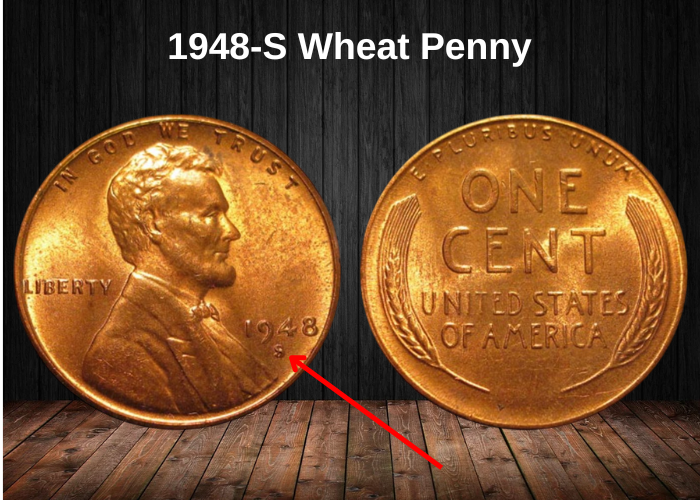
In 1948, the San Francisco Mint struck 81,735,000 Wheat Pennies, all bearing the “S” mint mark. These were regular circulation coins—not proofs.
Brown and Red-Brown Coins
Most brown (BN) 1948-S Wheat Pennies hold modest value. One graded MS66 BN sold for $72 on May 23, 2020, which is a respectable price for a copper cent.
Red-brown (RB) examples can command slightly higher premiums. For instance, an MS66 RB sold for $179 on February 15, 2023, also via eBay.
Red Coins and Market Trends
The highest-graded red (RD) example to date is MS67+ RD, with one selling for $1,998 on August 5, 2014. However, with over 70 coins now certified at this level by PCGS, their January 2025 value estimate has dropped to $1,050.
In the next tier down, MS67 RD, submissions have exceeded 300 coins, causing values to fall significantly—now sitting at just $160.
Rare 1948 Wheat Penny Errors List
The US Mint produces coins at an impressive rate, making hundreds of coins each minute. Despite their best efforts at quality control, some minting errors inevitably occur. These mistakes, such as double strikes, re-punched mint marks, and overdates, can significantly increase a coin’s value. If you’re a collector or investor, it’s essential to recognize these common errors as they can make your 1948 Wheat Penny much more valuable. Let’s take a closer look at these errors and explore their potential worth.
1948 (P) Wheat Penny DDO Error
The 1948 (P) Wheat Penny with a DDO (Doubled Die Obverse) error occurs when the die shifts slightly between hub strikes, causing the second impression to be slightly misaligned. This results in a doubled design, which is visible on parts of the coin, often around Lincoln’s ear or eye (hence the “doubled-eye” reference). While it’s an interesting error, it’s not particularly rare or valuable compared to other mint mistakes. Typically, a 1948 Wheat Penny with a DDO error in MS 65 RD can fetch between $12 and $25.
1948-D Wheat Penny Broadstruck Error
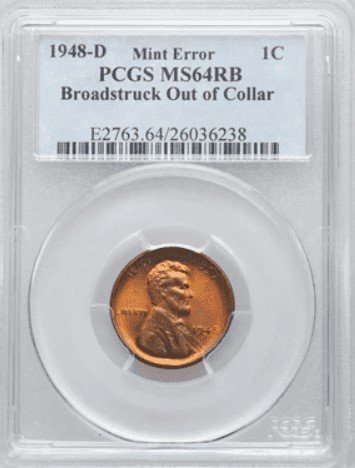
A broadstrike error occurs when a coin is struck without the collar that forms the rim, causing the coin to spread out beyond its intended size. This results in a flattened or widened edge. Broadstruck coins are considered minting errors, and they can be quite interesting to collectors. In the case of a 1948 Denver Wheat Penny with a broadstrike error, one that was graded MS 64 RB sold for around $85 at auction. This error adds some additional value to the coin due to its rarity and the unique characteristics of its strike.
1948-D Wheat Penny Struck 20% Off-Center
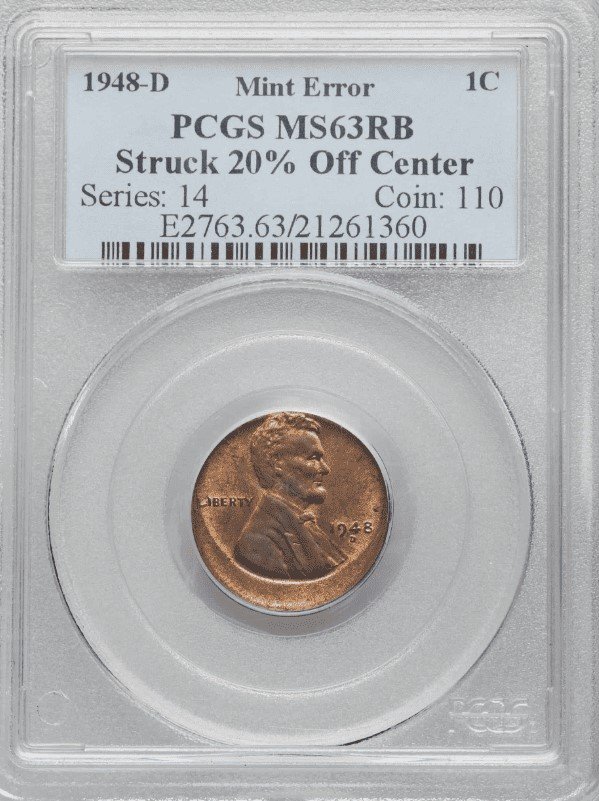
A misalignment or off-center error happens when the blank planchet shifts during the striking process, causing only part of the design to be stamped onto the coin. This results in a coin with a portion of the obverse or reverse missing the design. In this case, the lower obverse and upper reverse of the coin remained unmarked. A 1948 Wheat Penny with this misalignment error, graded MS 63 RB, was sold for around $110. Misalignment errors are often sought after by collectors due to their unique and unusual appearance.
1948-S/S Wheat Penny RPM Error
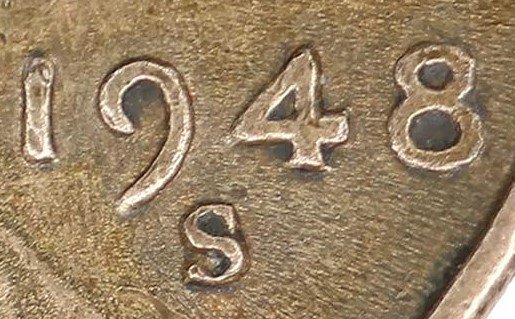
RPM stands for re-punched mint mark, a type of mint error that occurs when the mint mark is struck more than once, typically for clarity. In the past, mint marks were added manually as the last step in the coin production process. If the first punch wasn’t clear enough, the mint mark would be struck again. This created a re-punched mint mark, where traces of the earlier mint mark can be seen underneath the final one.
For a 1948 Wheat Penny with an RPM error, graded MS 66 RD, its value can reach around $70. This error adds to the coin’s uniqueness and appeal for collectors.
1948 (P) Wheat Penny Double Denomination Error
A double denomination error occurs when two coins are struck on the same planchet, creating a coin with two different denominations. In this case, a 1948 (P) Wheat Penny was accidentally struck with the design of a Franklin Half Dollar, resulting in a coin with both a 1 cent and a 50 cent design. The two designs appear at right angles to each other, with the larger 50c design being partially truncated.
This type of error is highly valuable due to its rarity. A 1948 Wheat Penny double denomination error, graded MS 64 BN, sold for an impressive $14,100. This showcases how unique and valuable minting errors can be in the world of numismatics.
1948 (P) Wheat Penny Straight Clip Error
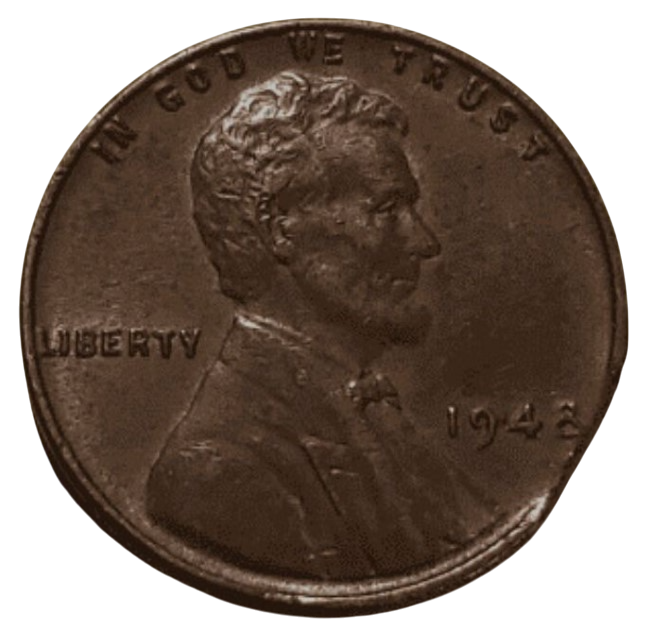
Blanks used for coin production come in large sheets that are flattened and then punched into individual planchets by a blanking machine. The leftover metal from this process typically has holes in it, which is recycled. However, if a coin is accidentally struck on the leftover metal, it can result in a clip error.
A straight clip occurs when a coin is struck near the end of the sheet, leaving a straight edge where part of the planchet is missing. These clipped coins are collectible due to their unusual appearance.
For example, an MS 64 BN straight clip error from the 1948 Wheat Penny series sold for $45, highlighting the added value these minting mistakes can have for collectors.
1948 (P) Wheat Penny Lamination Error
A lamination error occurs when a coin’s upper layer, or a portion of it, peels away from the rest of the planchet during the minting process. This can result in visible cracks, gashes, or even large chunks of the design being missing, creating a two-toned or damaged appearance on the coin.
For example, a 1948 (P) Wheat Penny with a lamination error may show a variety of distinctive flaws. One coin might have a portion of the obverse (the front side) completely truncated, effectively slicing off a third of Lincoln’s profile. Another example might give Lincoln an unusual “nose job,” where part of his nose or face is missing due to the peeling of the coin’s surface.
Lamination errors are often caused by issues with the blanking process, where faulty blanks (planchets) might have weak spots, leading to these types of surface issues when struck by the dies.
Collectors value these errors for their uniqueness, and they can often fetch higher prices depending on the severity of the error and the coin’s grade.
Where to sell your penny?
Now that you know the value of your penny, you might be wondering where to sell it. Don’t worry: here’s a guide to some of the best online platforms where you can easily sell your coins, along with their advantages and disadvantages.
Discover the best platforms for selling coins online (pros and cons).
1948 Wheat Penny FAQ
1. Why is the 1948 Wheat Penny important in U.S. coinage history?
The 1948 Wheat Penny holds historical importance because it was the last year the Wheat reverse design was used on U.S. pennies. After 1948, the Lincoln Memorial reverse design replaced the Wheat design in 1959. The 1948 penny also represents a transition period in the post-WWII economy when coin production was returning to normal, and the nation was entering a phase of economic growth.
2. What is the metal composition of the 1948 Wheat Penny?
The 1948 Wheat Penny is made from:
- 95% copper
- 5% zinc
This composition was used for pennies from 1909 through 1942 and then again from 1944 to 1948. It’s the standard alloy used for U.S. pennies before the mint switched to different compositions in the following decades, such as the 1962 copper-plated zinc alloy.
3. How many 1948 Wheat Pennies were minted?
The 1948 Wheat Penny had a significant mintage, ensuring it was widely circulated:
- Philadelphia (no mintmark): 1,092,110,000
- Denver (D): 430,490,000
- San Francisco (S): 282,760,000
With over 1.8 billion pennies minted, the 1948 Wheat Penny is quite common in circulated form, making it one of the most readily available coins in the Wheat series. However, due to its large mintage, it’s relatively less valuable compared to rarer coins in the series.
4. What is the value of a 1948 Wheat Penny today?
The value of a 1948 Wheat Penny depends on its condition:
- Circulated coins: Typically worth around $0.05 to $0.25.
- Uncirculated coins: Depending on the grade, MS-63 or MS-64 coins might be worth around $1 to $10.
- High-grade examples (MS-65 and above) may fetch $15 to $30, with MS-66 or better coins being particularly valuable to collectors.
Although the 1948 penny is common, finding a high-grade or error coin can increase its value significantly.
5. Are there any notable error varieties or rare finds in the 1948 Wheat Penny?
Yes, like other years in the Wheat series, the 1948 penny has error varieties that are of interest to collectors:
- Double Die Obverse (DDO): Some 1948 pennies show a doubled image on the obverse, especially in areas like the “LIBERTY” and “IN GOD WE TRUST” inscriptions. These errors make the coins more valuable to collectors who specialize in varieties.
- Off-center Strikes: As with many other coins, the 1948 penny may have been struck off-center, which results in a coin with parts of the design missing.
- Die Cracks and Cuds: Die cracks and cud errors can also appear on some 1948 pennies, resulting in coins with noticeable imperfections on the rim or in the design.
These error varieties can significantly increase the value of the coin, especially if found in high-grade condition.
6. How does the 1948 Wheat Penny compare to other Wheat Pennies, such as the 1947 or 1949?
- 1947 Wheat Penny: The 1947 penny is very similar in terms of mintage and design to the 1948 penny. However, the 1948 penny is the last of the Wheat reverse coins, which gives it a bit more historical significance. The 1947 penny generally holds a slightly lower value than the 1948 penny, but the difference is minimal.
- 1949 Wheat Penny: The 1949 penny is the first coin to feature the Lincoln Memorial reverse, and this marks the beginning of a new era in U.S. coinage. As such, the 1949 penny is often considered more collectible than the 1948 Wheat penny, especially in higher grades.
Overall, the 1948 penny remains one of the final coins with the iconic Wheat design, which makes it historically important, but its value is primarily based on its mintage and condition.
7. How can I identify a high-grade 1948 Wheat Penny?
To identify a high-grade 1948 Wheat Penny, you should focus on the following:
- Sharp, clean details: The wheat stalks, Lincoln’s portrait, and the inscriptions (“LIBERTY” and “IN GOD WE TRUST”) should be clear and sharp, with minimal wear.
- Minimal wear: A high-grade penny will show no wear on the high points of Lincoln’s face or the wheat stalks.
- Smooth, clean surfaces: Look for a coin with no scratches, dings, or tarnish. A well-preserved coin will have a smooth surface, with minimal marks.
- Luster: High-grade, uncirculated coins will have a noticeable luster, often described as a shiny or reflective finish. The coin will have no signs of circulation wear or abrasions.
Coins graded MS-65 or better are particularly valuable in high-grade conditions, and these often have brilliant luster and excellent eye appeal.



















































